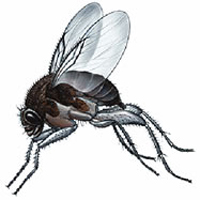|  Phorid
(Humpbacked) Flies Phorid
(Humpbacked) Flies
Order: Diptera
Family: Phoridae
Scientific Name: Various, Megacelia scalaris most
common
Color: Tan to dark brown
Legs: Six
Shape: Humpbacked appearance laterally
Size: Very smalló1/16- to 1/8-inch.
Antennae: Yes
Flight: Yes
The arched thorax of the adult gives the Phorid fly a humpbacked
appearance when viewed from the side. They are found throughout
the United States.
Habits
Some species feed on fungi, while others are parasites of various
insects. Larval food consists of moist decaying organic matter.
Several species breed in human corpses and are called "coffin
flies". The entire life cycle lasts 25 days or more, depending
on the environmental conditions and the availability of food.
Habitat
Characteristically short and erratic flight. Adults have a peculiar
habit of rapidly running across windows, TV screens, tables, walls
and plant foliage. These flies are frequently mistaken for "gnats."
Larvae develop in moist areas where organic material and standing
water are present. Phorid larvae also develop in animal matter.
Threats
Phorids are primarily a nuisance pest but cases have been reported
of Phorid larvae infesting wounds eyes and intestines of humans.
Because they like unsanitary places, they may transport various
desease-causing organisms to human food. They are of great concern
in health care facilities, mausoleums, zoos, and pet stores as weel
as homes.
Control
The key to eliminating Phorids is to find and eliminate all breeding
sources. Drains should be the initial inspection site when encountering
an infestation. The adults are often seen flying in areas located
away from the source of infestation.
(Source: National Pest Management Association, et. al.)
|